We all know that growing small peaches and nectarines is a sure way to go broke. Most peach and nectarine trees set more fruit than they can size. Flowers and young fruit compete for the limited reserves of carbohydrates and nutrients that the tree has accumulated during the previous autumn. So, too many flowers and young fruitlets lead to too many fruit—all small.
The market has become so demanding and competitive that only fruit growers who can consistently grow fruit of optimum size, high quality, and good taste stand a chance of survival. You could do this by pruning, shorten laterals and thin fruit to a yield target (see “Prune for size,” Good Fruit Grower, December 2012, and “Shorten laterals to cut thinning costs,” Good Fruit Grower, March 1, 2013).
To help you achieve a yield target, you could also remove (i.e., thin) some flowers early in the cropping cycle, so that the trees would produce the correct number and size of fruit, with higher yields. There are several meth
ods of thinning: a) hand-thinning (quick or precise), b) chemical thinning (blossom burners or growth regulators), and c) mechanical thinning.
Hand-thinning
Hand-thinning of flowers avoids risks of over- or underthinning, is simpler, and generates more predictable results than mechanical or chemical thinning. Also, hand-thinning can be done in any type of low or high-density orchard system.
Most fruit growers may think that hand-thinning is both costly and difficult to do correctly, so they overlook the benefits. However, once you know the fruiting habit of a variety, hand-thinning of flowers does not need to be costly and difficult, and can be more profitable than fruit-thinning only.
If you want to try hand-thinning of flowers, or want to get better at it, here are some hints. Use either a) quick hand-thinning to reduce the crop load or buy some time before fruit-thinning has to be completed, or b) precise hand-thinning.
With both methods, thin down from the top of the tree, to avoid knocking off remaining flowers in the bottom part. It is a quick way of getting a heavy bloom under control before the tree’s reserves run out. Whether you use quick or precise hand-thinning, remove the flowers at the popcorn stage (i.e., early in the cropping cycle).
Flowers come off easily at this stage when you gently run your gloved fingers along the topsides of the laterals. Flowers that face downwards set better fruit and are less prone to frost da
mage than are flowers that face upwards. With quick hand-thinning, remove about 50 percent of the flowers. With precise hand-thinning, leave 50 to 100 percent more flowers than you need. For example, if you need 2 fruit per lateral, leave 3 or 4 flowers per lateral. You may also have to do some fruit thinning later, but you will have plenty of time for that. Use precise
hand-thinning when you are confident of the fruit set. You must know the cropping potential and size required of each variety that yo
u want to hand-thin. Know the characteristic of fruit set of the variety that you want to hand-thin. Be aware of the varieties that set a lot of doubles or dummies.
These can substantially reduce yield after these fruit have been removed or have fallen off, and are often oversized or have disorders, such as split pits. Be aware of frost pockets in your orchard.
Hand-thinned trees are more exposed to frost than are trees that have not been hand-thinned. Always have some kind of frost protection in place. If you thin later than at the popcorn stage, you could damage the emerging leaves and new shoots. In so
me cases, if you have time, you can use precise hand-thinning as a follow-up, after you have used quick hand-thinning. Chemical blossom burners thin flow
ers before they are pollinated and fertilized, while growth regulators force flowers to abort after they
have been pollinated. It is difficult to obtain good, consistent results with blossom burners or growth regulators, because bad weather during and after application can alter the performance of these chemicals.
Mechanical thinning is done with a machine that is mounted on the front of a tractor, and has a vertical spinning spindle with plastic cables attached to it.
As the tractor moves through the orchard with the spindle spinning, the plastic cables thrash through the trees and remove flowers. Mechanical thinning avoids effects of bad weather, but may have to be followed up with extra hand-thinning to get the required crop loads.
The machine is suited to intensive planting systems with single plane canopies. In these circumstances, the economics of mechanical thinning appear to be plausible.
How all this works
Size of fruit depends on the total number and size of the individual cells that make up the fruit’s flesh. Cells of the flesh begin to form when the flower is fertilized, and the cells continue to divide. This period of cell division continues until the stone starts to harden.
After cell division, cells increase in size by filling up with water and sugar (period of cell enlargement) until the fruit is harvested. Final size of fruit is determined in about the first 30 days after full bloom, that is, during cell division. Strong competition between flowers, and also between flowers and young emerging shoots and leaves, can slow down cell division and lead to small fruit.
There is no way that you can increase the number of cells once cell division has ended and cell enlargement has started. To increase the number of cells, your trees must be in a good nutritional condition. Then you must fine-tune to get large fruit. In many ways, it is true to say that next year’s crop has already started to grow this season. This means that you must grow laterals this season to get a crop next year.
To grow the sizes of peaches and nectarines that the market wants, you must also be committed to detail throughout the year, because the crop load and size of fruit depend on many factors that start with proper management and health of trees, frost control, and ultimately thinning of flowers and fruit.
Thinning flowers takes some practice and good supervision, but commercial experience in Australia has shown that it is worthwhile if you want to stay in the business of growing fruit of good size and high quality. •

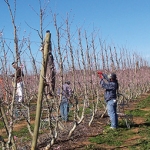
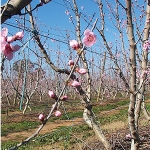
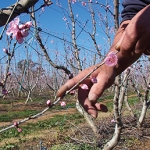
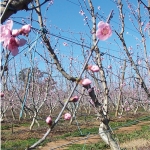


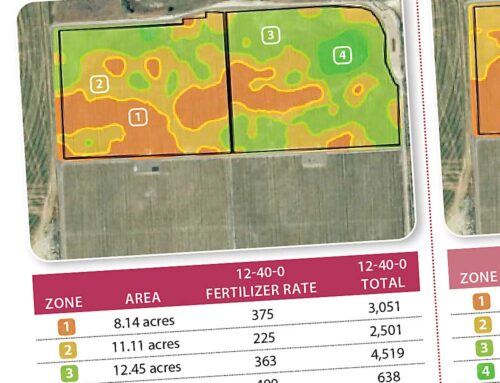

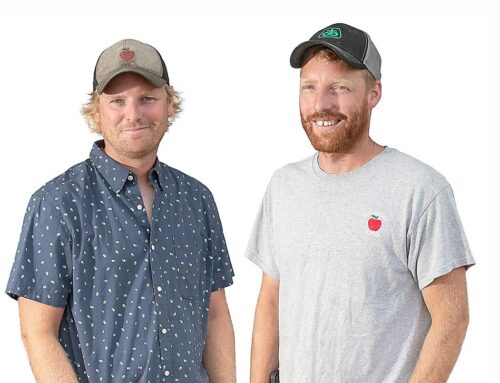
I don’t remove flowers…i remove small fruits as the possibility of late frost is over !!! And I get very big fruit :)